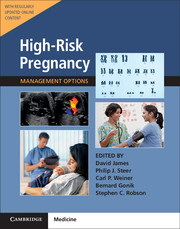Book contents
- High-Risk Pregnancy: Management Options
- High-Risk Pregnancy: Management Options
- Copyright page
- Contents
- Contributors
- Section 1 Prepregnancy Problems
- Section 2 Early Prenatal Problems
- Section 3 Late Prenatal – Fetal Problems
- Section 4 Problems Associated with Infection
- Chapter 24 Hepatitis Virus Infections in Pregnancy (Content last reviewed: 23rd July 2019)
- Chapter 25 Human Immunodeficiency Virus in Pregnancy (Content last reviewed: 23rd July 2019)
- Chapter 26 Rubella, Measles, Mumps, Varicella, and Parvovirus in Pregnancy (Content last reviewed: 11th November 2020)
- Chapter 27 Cytomegalovirus, Herpes Simplex Virus, Adenovirus, Coxsackievirus, and Human Papillomavirus in Pregnancy (Content last reviewed: 11th November 2020)
- Chapter 28 Parasitic Infections in Pregnancy (Content last reviewed: 15th June 2018)
- Chapter 29 Other Infectious Conditions in Pregnancy (Content last reviewed: 11th November 2020)
- Section 5 Late Pregnancy – Maternal Problems
- Section 6 Late Prenatal – Obstetric Problems
- Chapter 52 Abdominal Pain in Pregnancy (Content last reviewed: 15th October 2018)
- Chapter 53 Nonmalignant Gynecology in Pregnancy (Content last reviewed: 15th October 2018)
- Chapter 54 Bleeding in Late Pregnancy (Content last reviewed: 14th December 2020)
- Chapter 55 Multiple Pregnancy (Content last reviewed: 14th December 2020)
- Chapter 56 Threatened and Actual Preterm Labor (Content last reviewed: 14th December 2020)
- Chapter 57 Prelabor Rupture of the Membranes (Content last reviewed: 20th February 2020)
- Chapter 58 Breech Presentation, Unstable Lie, Malpresentation, and Malpositions (Content last reviewed: 14th December 2020)
- Chapter 59 Prolonged Pregnancy
- Chapter 60 Induction of Labor and Termination of the Previable Pregnancy
- Chapter 61 Dysfunctional Labor (Content last reviewed: 20th February 2020)
- Chapter 62 Shoulder Dystocia
- Chapter 63 Fetal Compromise in Labor (Content last reviewed: 15th December 2018)
- Chapter 64 Neuraxial Analgesia and Anesthesia in Obstetrics
- Chapter 65 Perineal Repair and Pelvic Floor Injury (Content last reviewed: 20th February 2020)
- Chapter 66 Assisted Vaginal Delivery (Content last reviewed: 15th December 2018)
- Chapter 67 Delivery After Previous Cesarean Section (Content last reviewed: 20th February 2020)
- Chapter 68 Cesarean Section (Content last reviewed: 20th February 2020)
- Section 7 Postnatal Problems
- Section 8 Normal Values
- Index
- References
Chapter 61 - Dysfunctional Labor (Content last reviewed: 20th February 2020)
from Section 6 - Late Prenatal – Obstetric Problems
Published online by Cambridge University Press: 15 November 2017
- High-Risk Pregnancy: Management Options
- High-Risk Pregnancy: Management Options
- Copyright page
- Contents
- Contributors
- Section 1 Prepregnancy Problems
- Section 2 Early Prenatal Problems
- Section 3 Late Prenatal – Fetal Problems
- Section 4 Problems Associated with Infection
- Chapter 24 Hepatitis Virus Infections in Pregnancy (Content last reviewed: 23rd July 2019)
- Chapter 25 Human Immunodeficiency Virus in Pregnancy (Content last reviewed: 23rd July 2019)
- Chapter 26 Rubella, Measles, Mumps, Varicella, and Parvovirus in Pregnancy (Content last reviewed: 11th November 2020)
- Chapter 27 Cytomegalovirus, Herpes Simplex Virus, Adenovirus, Coxsackievirus, and Human Papillomavirus in Pregnancy (Content last reviewed: 11th November 2020)
- Chapter 28 Parasitic Infections in Pregnancy (Content last reviewed: 15th June 2018)
- Chapter 29 Other Infectious Conditions in Pregnancy (Content last reviewed: 11th November 2020)
- Section 5 Late Pregnancy – Maternal Problems
- Section 6 Late Prenatal – Obstetric Problems
- Chapter 52 Abdominal Pain in Pregnancy (Content last reviewed: 15th October 2018)
- Chapter 53 Nonmalignant Gynecology in Pregnancy (Content last reviewed: 15th October 2018)
- Chapter 54 Bleeding in Late Pregnancy (Content last reviewed: 14th December 2020)
- Chapter 55 Multiple Pregnancy (Content last reviewed: 14th December 2020)
- Chapter 56 Threatened and Actual Preterm Labor (Content last reviewed: 14th December 2020)
- Chapter 57 Prelabor Rupture of the Membranes (Content last reviewed: 20th February 2020)
- Chapter 58 Breech Presentation, Unstable Lie, Malpresentation, and Malpositions (Content last reviewed: 14th December 2020)
- Chapter 59 Prolonged Pregnancy
- Chapter 60 Induction of Labor and Termination of the Previable Pregnancy
- Chapter 61 Dysfunctional Labor (Content last reviewed: 20th February 2020)
- Chapter 62 Shoulder Dystocia
- Chapter 63 Fetal Compromise in Labor (Content last reviewed: 15th December 2018)
- Chapter 64 Neuraxial Analgesia and Anesthesia in Obstetrics
- Chapter 65 Perineal Repair and Pelvic Floor Injury (Content last reviewed: 20th February 2020)
- Chapter 66 Assisted Vaginal Delivery (Content last reviewed: 15th December 2018)
- Chapter 67 Delivery After Previous Cesarean Section (Content last reviewed: 20th February 2020)
- Chapter 68 Cesarean Section (Content last reviewed: 20th February 2020)
- Section 7 Postnatal Problems
- Section 8 Normal Values
- Index
- References
Summary
The primary goal for all involved in the care of women in labor is a healthy mother and baby after delivery. For most pregnancies, which are low risk, delivery by cesarean section appears to pose greater risk of maternal morbidity and mortality than vaginal delivery and can have significant implications for future pregnancies.
- Type
- Chapter
- Information
- High-Risk PregnancyManagement Options, pp. 1749 - 1774Publisher: Cambridge University PressFirst published in: 2017



